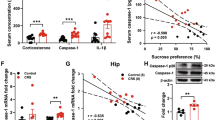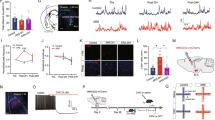Abstract
Pharmacological manipulation of mGluR5 has showed that mGluR5 is implicated in the pathophysiology of anxiety and mGluR5 has been proposed as a potential drug target for anxiety disorders. Nevertheless, the mechanism underlying the mGluR5 involvement in stress-induced anxiety-like behavior remains largely unknown. Here, we found that chronic restraint stress induced anxiety-like behavior and decreased the expression of mGluR5 in hippocampal CA1. Specific knockdown of mGluR5 in hippocampal CA1 pyramidal neurons produced anxiety-like behavior. Furthermore, both chronic restraint stress and mGluR5 knockdown impaired inhibitory synaptic inputs in hippocampal CA1 pyramidal neurons. Notably, positive allosteric modulator of mGluR5 rescued stress-induced anxiety-like behavior and restored the inhibitory synaptic inputs. These findings point to an essential role for mGluR5 in hippocampal CA1 pyramidal neurons in mediating stress-induced anxiety-like behavior.
This is a preview of subscription content, access via your institution
Access options
Subscribe to this journal
Receive 13 print issues and online access
$259.00 per year
only $19.92 per issue
Buy this article
- Purchase on Springer Link
- Instant access to full article PDF
Prices may be subject to local taxes which are calculated during checkout





Similar content being viewed by others
References
Remes O, Brayne C, van der Linde R, Lafortune L. A systematic review of reviews on the prevalence of anxiety disorders in adult populations. Brain Behav. 2016;6:e00497.
Huang SH, Liu WZ, Qin X, Guo CY, Xiong QC, Wang Y, et al. Association of increased amygdala activity with stress-induced anxiety but not social avoidance behavior in mice. Neurosci Bull. 2022;38:16–28.
Kessler RC, Berglund P, Demler O, Jin R, Merikangas KR, Walters EE. Lifetime preva- lence and age-of-onset distributions of DSM-IV disorders in the National Comorbidity Survey Replication. Arch Gen Psychiatry. 2005;62:593–602.
Luo ZY, Huang L, Lin S, Yin YN, Jie W, Hu NY, et al. Erbin in amygdala parvalbumin- positive neurons modulates anxiety-like behaviors. Biol Psychiatry. 2020;87:926–36.
Bluett EJ, Homan EJ, Morrison KL, Levin ME, Twohig MP. Acceptance and commit- ment therapy for anxiety and OCD spectrum disorders: an empirical review. J Anxiety Disord. 2014;28:612–24.
Ross RA, Foster SL, Ionescu DF. The role of chronic stress in anxious depression. Chronic Stress 2017;1:2470547016689472.
Kim KS, Han PL. Optimization of chronic stress paradigms using anxiety- and depre- ssion-like behavioral parameters. J Neurosci Res. 2006;83:497–507.
Pal MM. Glutamate: The master neurotransmitter and its implications in chronic tress and mood disorders. Front Hum Neurosci. 2021;15:722323.
Acher FC, Cabayé A, Eshak F, Goupil-Lamy A, Pin JP. Metabotropic glutamate receptor orthosteric ligands and their binding sites. Neuropharmacology 2022;204:108886.
Bodzęta A, Scheefhals N, MacGillavry HD. Membrane trafficking and positioning of mGluRs at presynaptic and postsynaptic sites of excitatory synapses. Neurophar- Macol. 2021;200:8799.
McCullock TW, Kammermeier PJ. The evidence for and consequences of metabotro- pic glutamate receptor heterodimerization. Neuropharmacology 2021;199:108801.
Esterlis I, Holmes SE, Sharma P, Krystal JH, DeLorenzo C. Metabotropic Glutamat- ergic Receptor 5 and Stress Disorders: Knowledge Gained From Receptor Imaging Studies. Biol Psychiatry. 2018;84:95–105.
Lin S, Li X, Chen YH, Gao F, Chen H, Hu NY, et al. Social isolation during adolescence induces anxiety behaviors and enhances firing activity in BLA pyramidal neurons via mGluR5 upregulation. Mol Neurobiol. 2018;55:5310–20.
Spooren WP, Vassout A, Neijt HC, Kuhn R, Gasparini F, Roux S, et al. Anxiolytic-like effects of the prototypical metabotropic glutamate receptor 5 antagonist 2-methyl-6- (phenylethynyl) pyridine in rodents. J Pharm Exp Ther. 2000;295:1267–75.
Klodzinska A, Tatarczyńska E, Chojnacka-Wójcik E, Nowak G, Cosford NDP, Pilc A. Anxiolytic-like effects of MTEP, a potent and selective mGlu5 receptor agonist does not involve GABA(A) signaling. Neuropharmacology 2004;47:342–50.
Fanselow MS, Dong HW. Are the dorsal and ventral hippocampus functionally distinct structures? Neuron 2010;65:7–19.
Ross TW, Easton A. The hippocampal horizon: constructing and segmenting experience for episodic memory. Neurosci Biobehav Rev. 2022;132:181–96.
Dang R, Zhou Y, Zhang Y, Liu D, Wu M, Liu A, et al. Regulation of Social Memory by Lateral Entorhinal Cortical Projection to Dorsal Hippocampal CA2. Neurosci Bull. 2022;38:318–22.
Günther A, Luczak V, Gruteser N, Abel T, Baumann A. HCN4 knockdown in dorsal hippocampus promotes anxiety-like behavior in mice. Genes Brain Behav. 2019;18:e12550.
Abela AR, Browne CJ, Sargin D, Prevot TD, Ji XD, Li ZX, et al. Median raphe serotonin neurons promote anxiety-like behavior via inputs to the dorsal hippocampus. Neuropharmacology 2020;168:107985.
Chang S, Bok P, Tsai CY, Sun CP, Liu H, Deussing JM, et al. NPTX2 is a key component in the regulation of anxiety. Neuropsychopharmacology 2018;43:1943–53.
Parfitt GM, Nguyen R, Bang JY, Aqrabawi AJ, Tran MM, Seo DK, et al. Bidirectional Control of Anxiety-Related Behaviors in Mice: Role of Inputs Arising from the Ventral Hippocampus to the Lateral Septum and Medial Prefrontal Cortex. Neuropsycho- Pharmacol. 2017;42:1715–28.
Jimenez JC, Su K, Goldberg AR, Luna VM, Biane JS, Ordek G, et al. Anxiety cells in a hippocampal-hypothalamic circuit. Neuron 2018;97:670–83.
Buynitsky T, Mostofsky DI. Restraint stress in biobehavioral research: Recent developments. Neurosci Biobehav Rev. 2009;33:1089–98.
Yang Y, Cui YH, Sang KN, Dong YY, Ni ZY, Ma SS, et al. Ketamine blocks bursting in the lateral habenula to rapidly relieve depression. Nature 2018;554:317–22.
Mah L, Szabuniewicz C, Fiocco AJ. Can anxiety damage the brain? Curr Opin Psychiatry. 2016;29:56–63.
Verpelli C, Dvoretskova E, Vicidomini C, Rossi F, Chiappalone M, Schoen M, et al. Importance of Shank3 protein in regulating metabotropic glutamate receptor 5 (mGluR5) expression and signaling at synapses. J Biol Chem. 2011;286:34839–50.
Kubota J, Mikami Y, Kanemaru K, Sekiya H, Okubo Y, Iino M. Whisker experience- dependent mGluR signaling maintains synaptic strength in the mouse adolescent cortex. Eur J Neurosci. 2016;44:2004–14.
Bekhbat M, Mukhara D, Dozmorov MG, Stansfield JC, Benusa SD, Hyer MM, et al. Adolescent stress sensitizes the adult neuroimmune transcriptome and leads to sex-specific microglial and behavioral phenotypes. Neuropsychopharmacology 2021;46:949–58.
Lei T, Dong D, Song MY, Sun YF, Liu XF, Zhao H. Rislenemdaz treatment in the lateral habenula improves despair-like behavior in mice. Neuropsychopharmacology 2020;45:1717–24.
Aubry AV, Khandaker H, Ravenelle R, Grunfeld IS, Bonnefil V, Chan KL, et al. A diet enriched with curcumin promotes resilience to chronic social defeat stress. Neuropsychopharmacology 2019;44:733–42.
Fischell J, Dyke AMV, Kvarta MD, LeGates TA, Thompson SM. Rapid Antidepressant Action and Restoration of Excitatory Synaptic Strength After Chronic Stress by Negative Modulators of Alpha5-Containing GABAA Receptors. Neuropsychopharmacology. 2015;40:2499–509.
Yim YS, Han W, Seo J, Kim CH, Kim DG. Differential mGluR5 expression in response to the same stress causes individually adapted hippocampal network activity. Biochem Biophys Res Commun. 2018;495:1305–11.
Lu YM, Jia Z, Janus C, Henderson JT, Gerlai R, Wojtowicz JM, et al. Mice Lacking Metabotropic Glutamate Receptor 5 Show Impaired Learning and Reduced CA1 Long-Term Potentiation (LTP) But Normal CA3 LTP. J Neurosci. 1997;17:5196–205.
Xu J, Zhu YL, Contractor A, Heinemann SF. Metabotropic glutamate receptor 5 (mGluR5) has a critical role in inhibitory learning. J Neurosci. 2009;29:3676–84.
Barnes SA, Pinto-Duarte A, Kappe A, Zembrzycki A, Metzler A, Mukamel EA, et al. Disruption of mGluR5 in parvalbumin-positive interneurons induces core features of neurodevelopmental disorders. Mol Psychiatry. 2015;20:1161–72.
Xu J, Antion MD, Nomura T, Kraniotis S, Zhu YL, Contractor A. Hippocampal Metaplasticity Is Required for the Formation of Temporal Associative Memories. J Neurosci. 2014;34:16762–73.
Kim CS, Chang PY, Johnston D. Enhancement of Dorsal Hippocampal Activity by Knockdown of HCN1 Channels Leads to Anxiolytic- and Antidepressant-like Behaviors. Neuron 2012;75:503–13.
Sun XD, Li L, Liu F, Huang ZH, Bean JC, Jiao HF, et al. Lrp4 in astrocytes modulates glutamatergic transmission. Nat Neurosci. 2016;19:1010–8.
Pérez MA, Peñaloza-Sancho V, Ahumada J, Fuenzalida M, Dagnino-Subiabre A. n-3 Polyunsaturated fatty acid supplementation restored impaired memory and GABAergic synaptic efficacy in the hippocampus of stressed Rats. Nutr Neurosci. 2018;21:556–69.
Mei L, Zhou Y, Sun Y, Liu H, Zhang DW, Liu PP, et al. Acetylcholine muscarinic receptors in ventral hippocampus modulate stress-induced anxiety-like behaviors in mice. Front Mol Neurosci. 2020;13:598811.
Hu W, Zhang MY, Czéh B, Flügge G, Zhang WQ. Stress impairs GABAergic network function in the hippocampus by activating nongenomic glucocorticoid receptors and affecting the integrity of the parvalbumin-expressing neuronal network. Neuropsychopharmacology 2010;35:1693–707.
Li MX, Li Q, Sun XJ, Luo C, Li Y, Wang YN, et al. Increased Homer1-mGluR5 mediates chronic stress-induced depressive-like behaviors and glutamatergic dysregulation via activation of PERK-eIF2α. Prog Neuropsychopharmacol Biol Psychiatry. 2019;95:109682.
Liu CY, Jiang XX, Zhu YH, Wei DN. Metabotropic glutamate receptor 5 antagonist 2-methyl-6-(phenylethynyl)pyridine produces antidepressant effects in rats: Role of brain-derived neurotrophic factor. Neuroscience 2012;223:219–24.
Singh B, Henneberger C, Betances D, Arevalo MA, Rodríguez-Tébar A, Meier JC, et al. Altered balance of glutamatergic/GABAergic synaptic input and associated changes in dendrite morphology after BDNF expression in BDNF-deficient hippocampal neurons. J Neurosci. 2006;26:7189–7200.
Spyrka J, Hess G. Repeated Neck Restraint Stress Bidirectionally modulates Excitatory Transmission in the Dentate Gyrus and Performance in a Hippocampus- dependent Memory Task. Neuroscience 2018;379:32–44.
Charalambakis NE, Govindaiah G, Campbell PW, Guido W. Developmental remodeling of thalamic interneurons requires retinal signaling. J Neurosci. 2019;39:3856–66.
Chung G, Shim HG, Kim CY, Ryu HH, Jang DC, Kim SH, et al. Persistent activity of metabotropic glutamate receptor 5 in the periaqueductal gray constrains emergence of chronic neuropathic pain. Curr Biol. 2020;30:4631–42.
Chong CH, Li Q, Mak PHS, Ng CCP, Leung EHW, Tan VH, et al. Lrrc7 mutant mice model developmental emotional dysregulation that can be alleviated by mGluR5 allosteric modulation. Transl Psychiatry. 2019;9:244.
Yu W, Kwon J, Sohn JW, Lee SH, Kim S, Ho WK. mGluR5-dependent modulation of dendritic excitability in CA1 pyramidal neurons mediated by enhancement of persistent Na+currents. J Physiol. 2018;596:4141–56.
Li DP, Zhu LH, Pachuau J, Lee HA, Pan HL. mGluR5 Upregulation increases excitability of hypothalamic presympathetic neurons through NMDA receptor trafficking in spontaneously hypertensive rats. J Neurosci. 2014;34:4309–17.
Chen M, Shu S, Yan HH, Pei L, Wang ZF, Wan Q, et al. Hippocampal Endothelin-1 decreases excitability of pyramidal neurons and produces anxiolytic effects. Neuropharmacology 2017;118:242–50.
Funding
This work was supported by grants from the STI2030-Major Projects (2021ZD0202704), the National Natural Science Foundation of China (82090032, 31830033, 32200950), the Key-Area Research and Development Program of Guangdong Province (2018B030334001, 2018B030340001), the Science and Technology Program of Guangzhou (202007030013), Basic and Applied Basic Research Foundation of Guangdong Province, China (2022A1515011106).
Author information
Authors and Affiliations
Contributions
T-MG proposed the concept and designed the experiments. XL, Z-JD. J-NX, Z-ML, SL, HC, and S-JL performed the experiments. XL, Z-JD, and X-WL analyzed the results. XL and Z-JD interpreted the results. T-MG, J-MY, and XL wrote and edited the manuscript.
Corresponding author
Ethics declarations
Competing interests
The authors declare no competing interests.
Additional information
Publisher’s note Springer Nature remains neutral with regard to jurisdictional claims in published maps and institutional affiliations.
Supplementary information
Rights and permissions
Springer Nature or its licensor (e.g. a society or other partner) holds exclusive rights to this article under a publishing agreement with the author(s) or other rightsholder(s); author self-archiving of the accepted manuscript version of this article is solely governed by the terms of such publishing agreement and applicable law.
About this article
Cite this article
Li, X., Du, ZJ., Xu, JN. et al. mGluR5 in hippocampal CA1 pyramidal neurons mediates stress-induced anxiety-like behavior. Neuropsychopharmacol. 48, 1164–1174 (2023). https://doi.org/10.1038/s41386-023-01548-w
Received:
Revised:
Accepted:
Published:
Issue Date:
DOI: https://doi.org/10.1038/s41386-023-01548-w
This article is cited by
-
The role of mGluR5 on the therapeutic effects of ketamine in Wistar rats
Psychopharmacology (2024)



